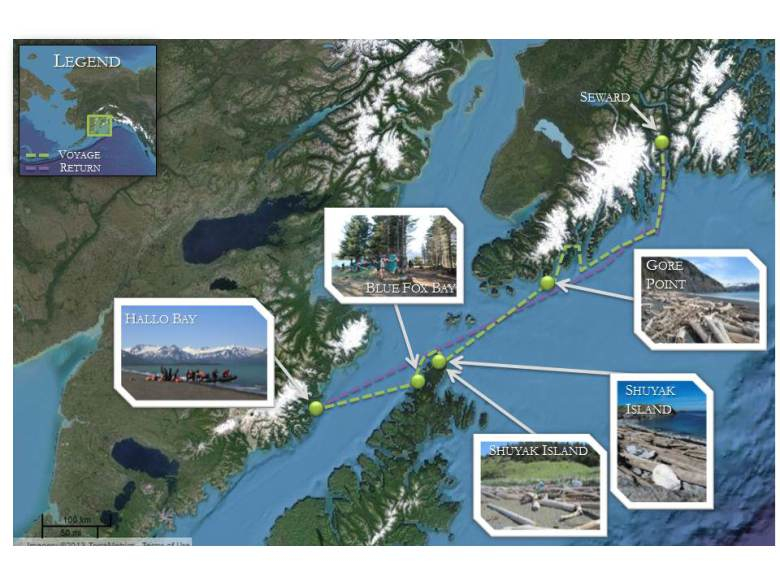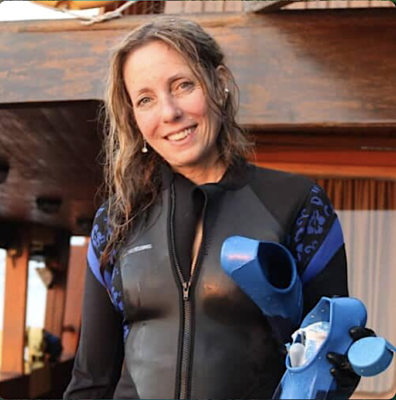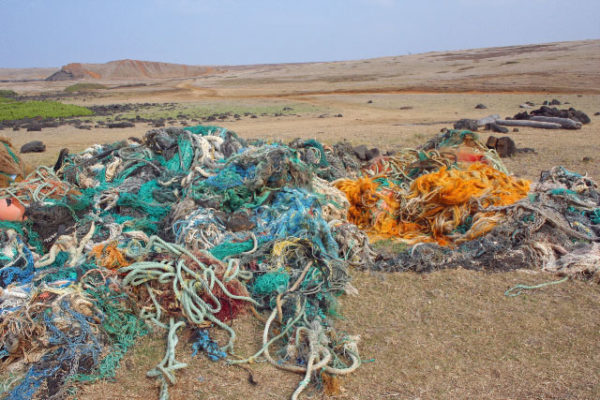June 8, 2013 – Gore Point, Gulf of Alaska
By 6:30 am, after the 9 hour passage from Seward in pitching 6 Ft+ swell, we stirred from bed to find ourselves in a glass-flat cove in complete silence. Full of asparagus frittata by the remarkable Norseman chef Aaron, we began mustering for our first beach landing at Gore Point.
This particular location is achingly scenic, a beachhead strewn with a massive log berm studded with large blocks of styrofoam, the giant black buoys of tsunami debris and a shipwreck; slivery seal heads watch us from the surf. In approaching the site, it is important to me to try and read the message of the arrangements and juxtapositions of how things lie: I photograph these. My first photo was of a black rectangular shark egg case lined up in tandem with a similarly shaped black quart oil bottle: parallel universes of life and death.
Mark Dion spent the afternoon collecting smallish objects that he arranged into an impromptu construction on the black sand. Andy Hughes patiently balanced flyswatters and balls on the end of sticks to photograph. My unofficial survey put the single most ubiquitous object (aside from the billions of styrofoam balls) as sponge-foam miniature sports balls: soccer, basketball, volleyballs.
The second most common single object were black flyswatters with university and sports team logos. Why are there so many of these? A container ship spill in 2011 released thousands of these two types of useless junk all over Alaskan beaches, and one type less useless: hummingbird feeders. I found one of the red plastic fake flowers deep in the forest a hundred yards from the beach. It is sickening to imagine the sheer numbers of new plastic garbage objects lost during shipping when the annual estimate of worldwide containers spills is estimated as high as 10,000.
No matter how overwhelming the sheer volume of plastic is, I can’t leave a beach without collecting and carrying out as much of it as I physically can. This day I exhausted myself collecting loads that Andy and Howard Ferren and I dragged through the 20 minute forest walk to the landing beach. Much plastic is very light, but many of the round floats are made of 1 inch thick HPDE and weigh a lot. What one person can remove is just a drop in the ocean, but every piece we take is one less piece that will end up in a bird, a turtle or smashed to smithereens of microplastic. I am particularly interested in the black plastic: it more symbolically represents the dark nature of plastic. I am imagining an artwork that juxtaposes a giant black form spewing forth the multicolored eye-candy of floats, nets, products.
June 9, 2012
Saw many dalls porpoises, an orca, many humpbacks and a big whale skull today. Weather is amazing! More soon.
June 10, 2013 – Red Buoy Beach, Shuyak Island, Kodiak Archipelago
We journey overnight to Shuyak Island, part of the Kodiak Island archipelago. No human habitation in these parts, but there will certainly be plastic. This area is home to the largest grizzly bears in Alaska. As the scale of everything in Alaska is already supersized, these bears are absolutely enormous. I hope we see one. It’s their home, and it would be a rare privilege.
We find many floats, more tsunami styrofoam blocks, a giant tanker container, a childs stubby flipper, a surfboard skeg and a 1″ long Hello Kitty head. Yes there are surfers in Alaska, there’s even a Surfrider Chapter in Homer. They surf winter waves too. Alaskans are super tough.
Check out the gallery for to see a portion of our plastic collection after 2 days on the deck of the Norseman with artists Mark Dion, Karen Larsen and expedition leader Howard Ferren; the film crew shooting deck hands stowing the plastic in container for shove off; and UK surfer/artist Andy Hughes shooting the Smithsonian’s spectroscopy lab.
June 11, 2013 – Hallo Bay, Alaska Peninsula, Katmai National Park
Our final leg of the journey was a joint venture between the National Park Service at Kamai National Park and the GYRE expedition. Katmai is a nearly 5 million acre park that is the preserve of the largest bears on earth, the Alaskan brown bear, a close relative but a separate sub-species from the grizzly bear. They are beach bears that grow enormous on a fish and plant based diet of clams, salmon, sedge grass and blueberries. Two bays down is the location of Timothy Treadwell’s lifework of bear observation and activism, the subject of my favorite director Werner Herzog’s film ‘Grizzly Man.’ This is remote territory, accessible only by plane or boat, and it, too was jammed with plastic.
From a half-mile offshore as we approach the enormous 5-mile beach, we can see orange dots studding the shore. These are the bagged trash piles of plastic garbage that 6 National Park Rangers collected in a 3-day period. It turned out to be over two TONS of primarily nets, both hard plastic and styrofoam floats, and umpteen million product bottles. We did a boat relay with the Jubatus, the steel landing boat and the Achilles inflatable, the land based crew sweeping along the 5-mile stretch from pile to pile and then passing down the beach to the boats. The boats then shuttled the loads to the 108′ former crabbing-ship-made-luxury-research-vessel, the Norseman. By the end of the 12-hour day, the Norseman’s decks were entirely filled with 3 tons of ocean trash.
The bears were all around us, sometimes surprising us by suddenly appearing from around a rock ledge. One sub-adult appeared this way, very jittery and nervous, spending its first summer alone after the mothers abrupt banishment to grow up on its own. He was pushing a mother and cubs along the beach, making her very nervous. Males will sometimes eat the cubs.
We continued to pick up more plastic and observe the bears. With us were 3 rangers and Park Superintendent Diane Chong, the woman who is in charge of the 5-million acre park. The bears were clamming in the mudflats. A mother bear decides to approach us, and she plods directly for us, up a huge log into our midst, not 12 feet away with her 3 precious weeks-old cubs. They are curious, standing on hind legs, tumbling over one another, climbing on her back. The mother bear lays down, clearly relaxed, blinky and with the mouth-half-open expression of a happy dog. She approached us on her terms, not seeing us as a threat, but as company, and a place to feel safer from the sub-adult male that we had seen pressuring her to chase up the beach. It was a sublime moment that left many of us with tears streaming, sharing space with an 800 lb. Alaskan brown bear, at her choice. It seemed we were given back a rare exquisite mystical gift of interspecies connection as acknowledgement or thanks for our work.
Onboard, Smithsonian scientist Odile Madden scans our samples with an electron spectroscope for molecular content revealing plastic type, surface contaminants and heavy metals. Some of the Asian fishing floats show the presence of lead. Nick Mallos of Ocean Conservancy is collecting bottle caps (numbering in the 1000s) to survey the branding prevalence. The artists onboard are drawing, photographing and writing. Nat Geo photographers are working 16 hour days making their film and photo documentation.
After 2 days in Katmai, the Norseman sets sail for the 22-hour return to Seward. At the dock we offload 3 tons of material that will be sorted for the museum project, some of it recycled, and the rest of it heads to the landfill. That is the state of affairs for most cleanups worldwide because we haven’t yet figured out what to do with this stuff.




















